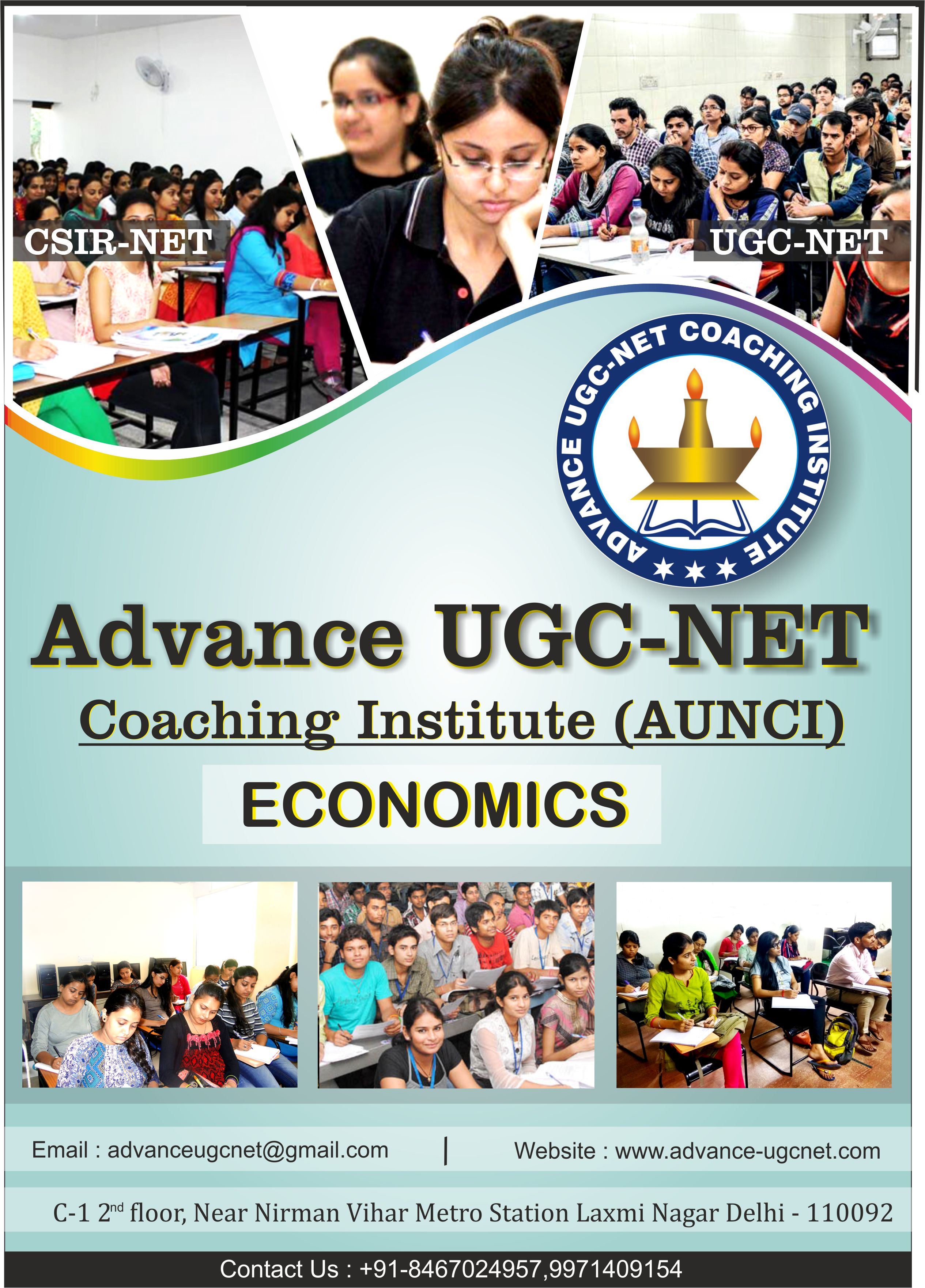ADVANCE ONLINE UGC-NET ECONOMICS

Greetings UGC NET Aspirants! 😊
When it comes to a vast subject like economics midnight doubts or confusion can come along very easily which can lead to tangled state of mind for all the students. It is inevitable to have doubts but it is even easier to solve them when you have live sessions and a panel of tutors just a button away. Get a chance to study for UGC Net whenever and wherever you want.
Advance Ugc net coachign institute is providng online ugc net coaching on Ugcnet ECONOMICS , we are providing live face to face intraction classses on virtual class room software.
Question paper Ist and IInd Pattern
Paper Ist contains 50 questions 2 marks each and Paper II contains 100 questions 2 marks each.
All questions are objective type questions (MCQs, True/False, Assertion-Reasoning).
All questions are compulsory. No negative marking.
UGC NET Economics Syllabus Paper II
Here we are providing detailed syllabus of UGC NET Economics Syllabus Paper II which has been mentioned in below table section wise.
Unit-1 : Micro Economics
- Theory of Consumer Behaviour
- Theory of Production and Costs
- Decision making under uncertainty Attitude towards Risk
- Game Theory – Non Cooperative games
- Market Structures, competitive and non-competitive equilibria and their efficiency properties
- Factor Pricing
- General Equilibrium Analysis
- Efficiency Criteria: Pareto-Optimality, Kaldor – Hicks and Wealth Maximization
- Welfare Economics: Fundamental Theorems , Social Welfare Function
- Asymmetric Information: Adverse Selection and Moral Hazard
- National Income: Concepts and Measurement
- Determination of output and employment: Classical & Keynesian Approach
- Consumption Function
- Investment Function
- Multiplier and Accelerator
- Demand for Money
- Supply of Money
- IS – LM Model Approach
- Inflation and Phillips Curve Analysis
- Business Cycles
- Monetary and Fiscal Policy
- Rational Expectation Hypothesis and its critique
- Probability Theory: Concepts of probability, Distributions, Moments,Central Limit theorem
- Descriptive Statistics – Measures of Central tendency & dispersions,Correlation, Index Numbers
- Sampling methods & Sampling Distribution
- Statistical Inferences, Hypothesis testing
- Linear Regression Models and their properties – BLUE
- Identification Problem
- Simultaneous Equation Models – recursive and non-recursive
- Discrete choice models
- Time Series Analysis
- Sets, functions and continuity, sequence, series
- Differential Calculus and its Applications
- Linear Algebra – Matrices, Vector Spaces
- Static Optimization Problems and their applications
- Input-Output Model, Linear Programming
- Difference and Differential equations with applications
- International Trade: Basic concepts and analytical tools
- Theories of International Trade
- International Trade under imperfect competition
- Balance of Payments: Composition, Equilibrium and Disequilibrium and Adjustment Mechanisms
- Exchange Rate: Concepts and Theories
- Foreign Exchange Market and Arbitrage
- Gains from Trade, Terms of Trade, Trade Multiplier
- Tariff and Non-Tariff barriers to trade; Dumping
- GATT, WTO and Regional Trade Blocks; Trade Policy Issues
- IMF & World Bank
- Market Failure and Remedial Measures: Asymmetric Information,Public Goods, Externality
- Regulation of Market – Collusion and Consumers’ Welfare
- Public Revenue: Tax & Non-Tax Revenue, Direct & Indirect Taxes, Progressive and non-Progressive Taxation, Incidence and Effects of Taxation
- Public expenditure
- Public Debt and its management
- Public Budget and Budget Multiplier
- Fiscal Policy and its implications
- Components of Money Supply
- Central Bank
- Commercial Banking
- Instruments and Working of Monetary Policy
- Non-banking Financial Institutions
- Capital Market and its Regulation
- Economic Growth and Economic Development
- Theories of Economic Development: Adam Smith, Ricardo, Marx, Schumpeter, Rostow, Balanced & Unbalanced growth, Big Push approach.
- Models of Economic Growth: Harrod-Domar, Solow, Robinson,Kaldor
- Technical progress – Disembodied & embodied; endogenous growth
- Indicators of Economic Development: PQLI, HDI, SDGs
- Poverty and Inequalities – Concepts and Measurement
- Social Sector Development: Health, Education, Gender
- Environment as a Public Good
- Market Failure
- Coase Theorem
- Cost-Benefit Analysis and Compensation Criteria
- Valuation of Environmental Goods
- Theories of Population
- Concepts and Measures: Fertility, Morbidity, Mortality
- Age Structure, Demographic Dividend
- Life Table
- Migration
- Economic Growth in India: Pattern and Structure
- Agriculture: Pattern & Structure of Growth, Major Challenges, Policy Responses
- Industry: Pattern & Structure of Growth, Major Challenges, Policy Responses
- Services: Pattern & Structure of Growth, Major Challenges, Policy Responses
- Rural Development – Issues, Challenges & Policy Responses
- Urban Development – Issues, Challenges and Policy Responses.
- Foreign Trade: Structure and Direction, BOP, Flow of Foreign Capital, Trade Policies
- Infrastructure Development: Physical and Social; Public-Private Partnerships
- Reforms in Land, Labour and Capital Markets
- Centre-State Financial Relations and Finance Commissions of India;FRBM
- Poverty, Inequality & Unemployment

